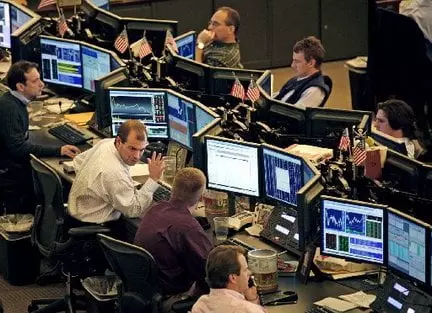However, along with the changes, there are also opportunities for prop firms.. Volcker's Rule (Volcker Rule) in the USA and steps, undertaken in Europe to separate prop-trading units from retail banks, will reduce the volume of prop-prepping in banks and further promote traditional prop firms.
In the short term, this will reduce liquidity, and also provide an opportunity to recruit talented people, leaving banks. But prop-trading firms also have big short-term problems.. Rising technology costs hit the bottom line, while lower volumes reduce traders' opportunities.
At the same time, many traditional traders, manual trading, defend the right to stay in the markets, in power high-frequency trading (High Frequency Trading, HFT).
Prop companies introduce various innovations, to adjust. Changing dynamics of prop trading was one of the topics of discussion at the European conference on options, organized by FOW magazine 9 April in Amsterdam. In particular, the participants discussed, how the growing tendency to internalize is affecting the private trading business (internalizing) flow of applications, which started in the stock markets, but increasingly extending to exchange-traded derivatives (exchange-traded derivatives, ETD).
Transparency versus competition
Traditionally started in larger investment banks, the practice of internalization is increasing its spread. Internalization allows the trading desk to pick up internal orders, reducing the exchange commission and therefore offering cheaper trades. In today's regulatory environment, internalization correlates in different ways with different regulatory goals.
On the one side, this reduces costs for the end user and provides the necessary competition for exchanges, and on the other hand there is a possibility, that it will wash liquidity out of established and transparent exchanges and move it to unregulated and non-transparent, Creating hidden liquidity pools.
Markets in Financial Instruments Directive (Markets in Financial Instruments Directive, MiFID I) focused on encouraging competition in stock markets, and as a result, liquidity in these markets has become fragmented, since firms could form their own hidden pools, cross-network brokers and internalization tools.
The growth in the internalized flow can then to a large extent be written directly into MiFID I. But this mostly applies to stocks, which can be more naturally fragmented due to interchangeability. Now the question is, will internalization spread to stock markets, derivatives trading, which are not interchangeable.
“If you asked me about internalization six months ago, it would be completely confusing. But since November, our local firms have been allowed to trade in hidden pools and fill out their applications for 35% more" – said Neil Crammond (Neil Crammond) – risk manager of the London-based trading firm Futex.
Crammond said, that hidden pool provider Futex is asking for a price per trade on 30% less, than the exchange, and therefore traders are able to significantly improve their profit and loss statements
Another fact is, that in some prop companies, trading in hidden pools, at the pool operator, unlike the exchange, you have the right to decide who can be traded in the pool, and who does not.
In practice, this means that, what the hidden pool operator can prevent from trading HFT-firms, and there are a significant number of firms on the market, including most London prop firms, for whom a non-HFT trading environment is an attractive prospect.
"Traders, manual trading, fought, so that Skoda cars keep up with the Ferrari-HFT, and maybe part of the market was on the side of hidden pools " – said Crammond.
Internalization Necessary for Survival
In the past, exchanges were against internalization, since it reduces their volumes and, accordingly, income. However, from one source it became known, that exchanges decided to consider hidden pools a necessary evil, which will have to endure, to keep liquidity providers in business.
"Badly, if prop traders switch to internalization platforms, but if it goes on for a year or two, then it will be good, because market conditions may improve, and they will be able to continue trading on the exchange. Obviously, that not all of their trades will go through internalization platforms, most will still go through the exchange " – they believe.
In response to the challenge from internalization, exchange groups were able to establish similar platforms, such as the Multilateral Marketplace (Multilateral Trading Facilities), Brokerage cross-networks or Systemized Marketplace (Organised Trading Facilities, OTF), featured in Mifid II.
Although such an action would take some volume from the exchange floor and fragment the liquidity of the site, but that means, that the exchange would keep the prop firms' business instead of, to lose it to other hidden pool providers.
Final rules for Mifid II are still missing, although unclear, will it allow the development of brokerage cross-networks, will OTF replace them, what will OTF look like or what will be the requirements for work.
“Essentially a hidden pool is a return to the trading floor and therefore the only, what exchanges can do to possibly counter this - play the same game, Like everyone else, and install the platform, which has a different regulatory structure " – remarked by the panelist, unknown under the Chatham House privacy policy (Chatham House Rules).
Then the exchanges would claim, that they have a wider pool and can offer customers a single hidden pool. But really., it's not the same, what the exchanges want, as the result will be even more fragmentation.
Hidden liquidity
Although internalization currently benefits pro-firms, Crammond claims, that it goes against many regulatory principles, who are trying to implement market governing bodies.
"Perhaps, in two or three years we will look back and see, how much liquidity the market has lost, and we will see more evil in hidden pools, than in HFT».
“I can safely assume, that the volumes of hidden pools will grow from 25% to 30% over the next 12-18 Months, and I think, what they, probably, now pose a big threat to the market, than HFT used to be " – he added.
According to one of the sources, liquidity is flushed out of the exchange., as evidenced by the fact, that, compared to five years ago, the depth of the market for such a contract has decreased, like Bund Futures.
“Now there is still liquidity, you just don't see her mainly because, what people, who previously placed orders in the Depth of Market, don't do it anymore, And Brokers trying to outplay algorithms with algorithms.".
“Everyone is financing a little VWAP, TWAP or other algorithms, and thus no one knows exactly how things are. Maybe, there is much more liquidity, what everyone thinks, but it's hard to understand what's inside ".
There is also a potential danger for operators of internalized engines., which may stop rolling positions in a day due to trading mismatches at the long and short ends.
An example of this is Marex Spectron, which acquired Schneider and its hidden pool, front-end related. Traders could open a long position in this pool - a two-way transaction - and then take the corresponding short position during the day., but this time trading through the exchange.
According to the operator of the internalized engine, trader's position - flat, but since the exchange is concerned, that he sees only one side of the deal, then the owner of the internalized engine will have to transfer positions to the exchange, until they can determine the full position in relation to others. It means, what firm, in our case Marex Spectron, must disburse funds at the end of the business day of any such inconsistency between OTC (over-the-counter, OTC) trades and ETDs.
New market makers
As prop traders seek new business opportunities, resulting from changes in the regulatory framework, some market participants are wondering, but can prop firms replace banks as market makers?.
In addition, regulatory pressure is forcing banks to leave this role., but currently prop firms are not subject to this regulation and therefore may become market makers, if they count, that it will benefit them.
“From the side of prop companies, I noticed, what 15 or 20 years ago, everyone wanted to be market makers, because it was in your favor, exchanges gave you breaks (breaks), and the profit was good ".
“Over the past five years, everything has changed a little, and now I see exchanges, promptly following these prop firms in the stream. Prop-firms are going to replace market makers?» – asks Gerald Perez (Gerald Perez), managing director Interactive Brokers.
This question remains unanswered at this time.. Market makers do still have an edge on the exchange, not least due to lower trading fees, but requirements, which prop firms must agree to, still scare off many of them.
Besides, some market makers complain, that they are disadvantaged when trading against firms with the same or lower latency (latency), but who do not have to sit in the market or receive a certain number of quotes. In addition, there are technological barriers to market entry., what can be a significant obstacle.
In most cases, prop firms can avoid these problems and still enjoy the benefits, provided by exchanges, without becoming a market maker. For example, Eurex offers volume discounts to those market participants, who operate with a large volume, but do not want to invest money, Wasting time, or risk, becoming a market maker.
This volume discount is not a brand new commission, and she's not as good as commissions, offered to market makers, but it reduces the costs of trading firms, and they save money without having to fulfill the requirements of market makers.
If the prop firm reaches the performance, required for volume discount, then the incentive to become a market maker will undoubtedly decrease.
The future of prop firms
Prop traders vote their businesses, and now it seems, that they opted for hidden pools and internalized platforms. Not known yet, what will they do as potential market makers.
Although trading conditions remain tight, prop firms can adapt well to the changing industry landscape and will play a key role in moving forward.
Transfer :
A source:



